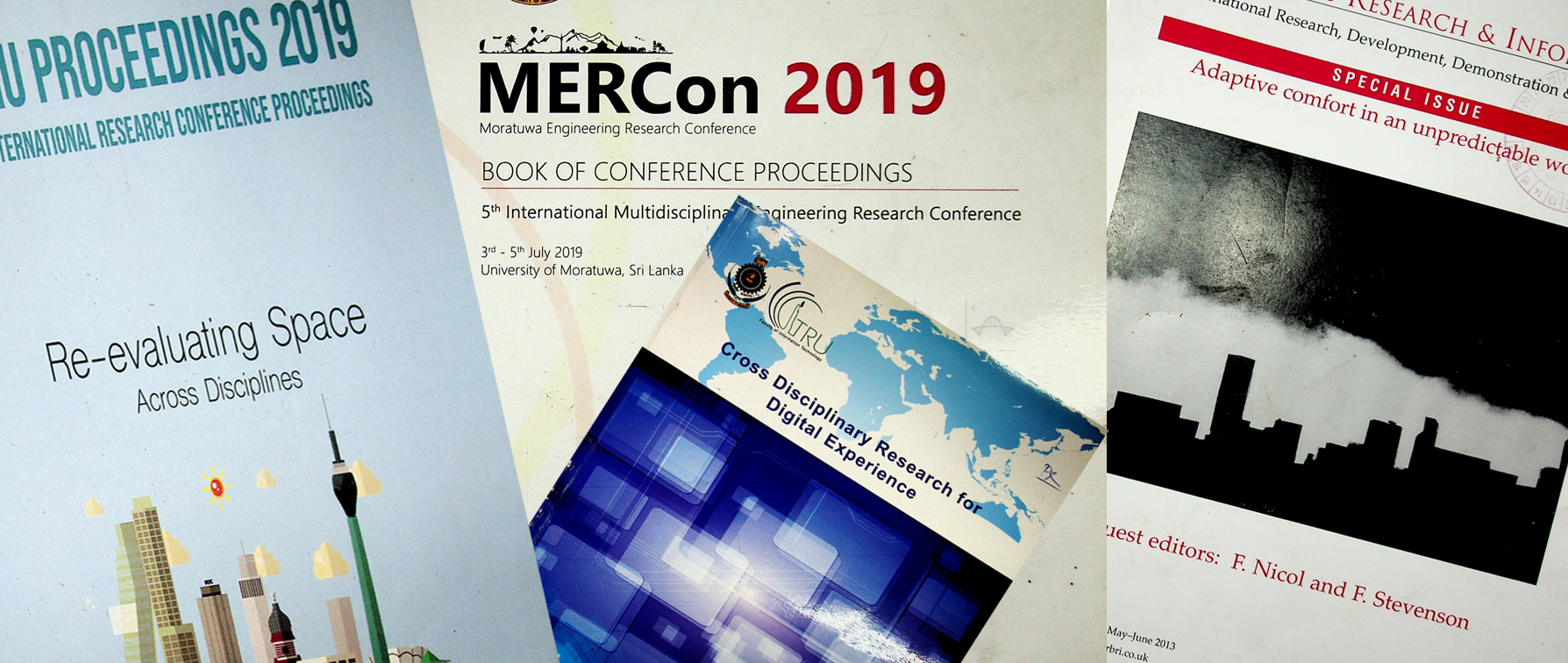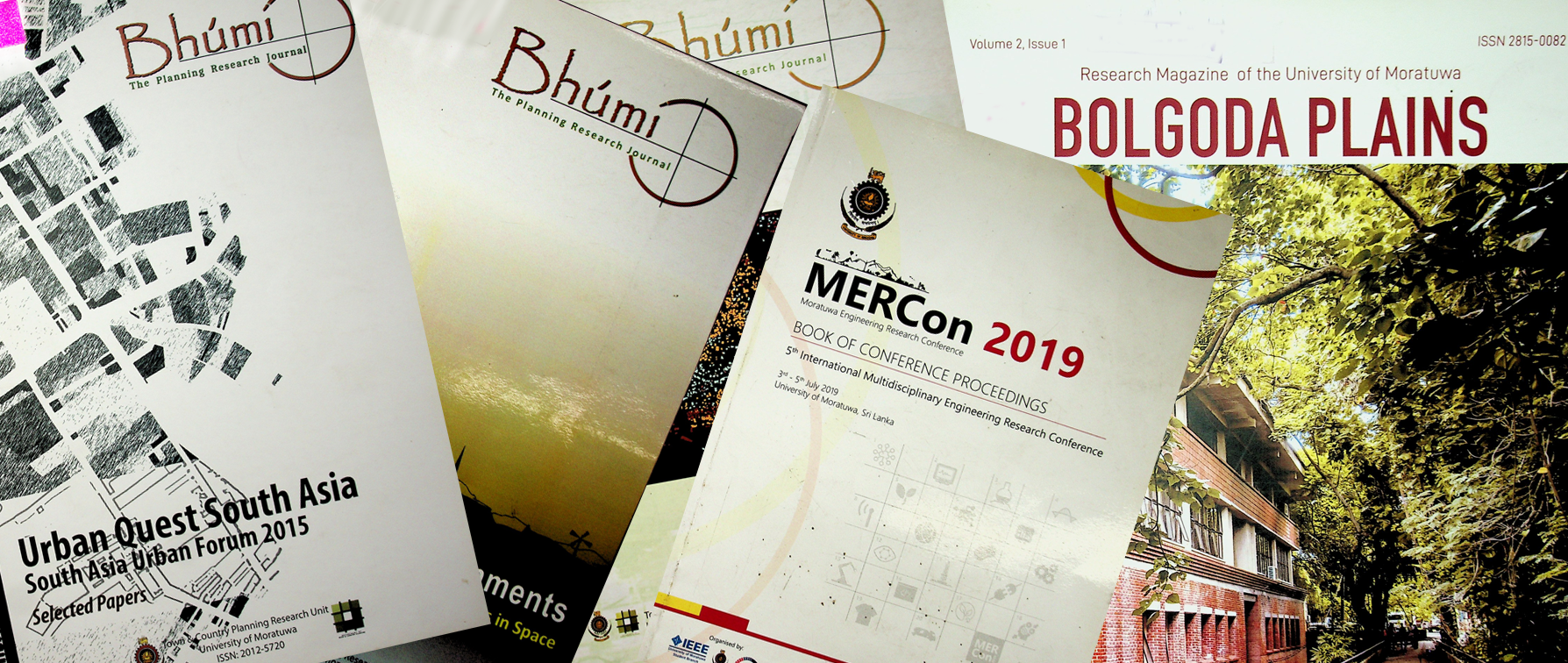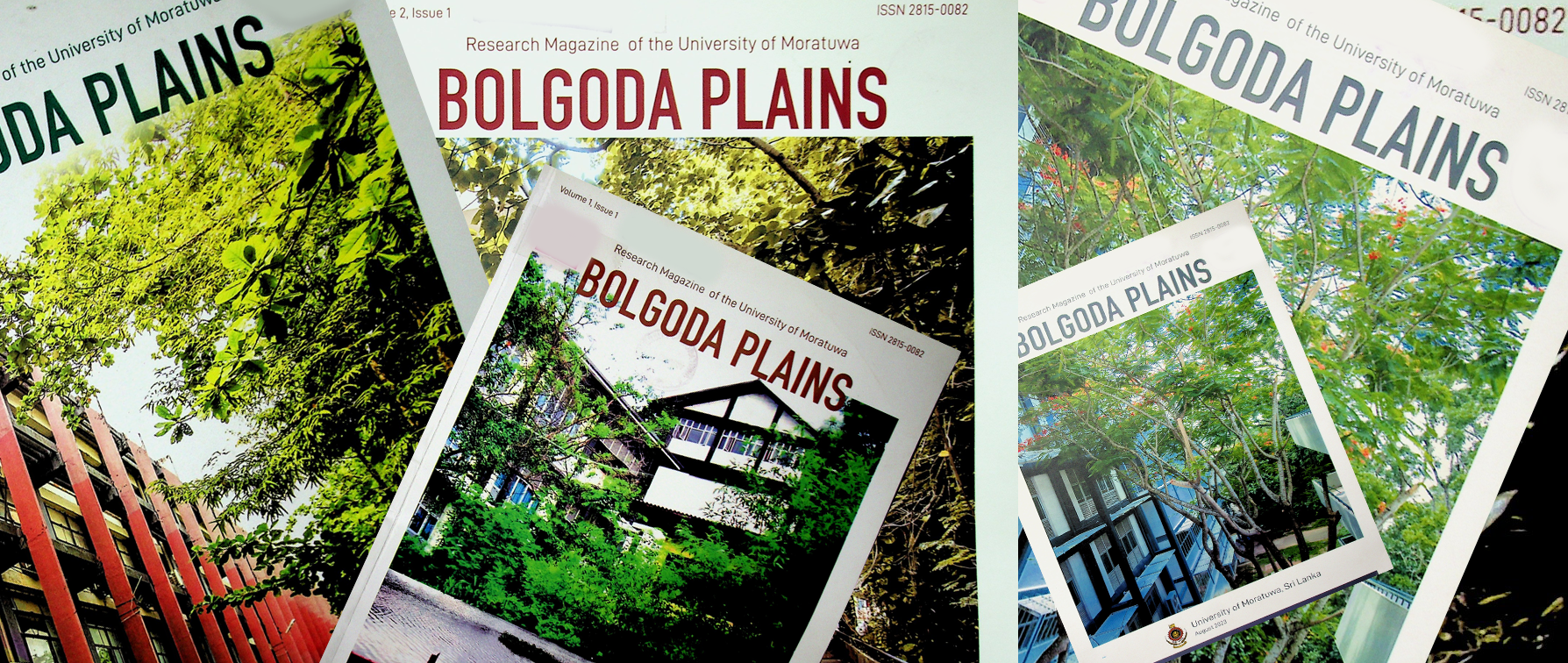Institutional-Repository, University of Moratuwa
Welcome to the University of Moratuwa Digital Repository, which houses postgraduate theses and dissertations, research articles presented at conferences by faculties and departments, university-published journal articles and research publications authored by academic staff. This online repository stores, preserves and distributes the University's scholarly work. This service allows University members to share their research with a larger audience.
 Research Publications |  Thesis & Dissertation |  E- Books |



 UoM Journal Publications |  UoM Conference Proceedings |  Articles published in Scimago's Q1 journals |  UoM Research Reports |  Other Articles authored by UoM staff |
Recent Submissions
item: Conference-Full-text
International Symposium on Earth Resources Management and Environment - ISERME 2025 (Pre-Text)
(Department of Earth Resources Engineering, University of Moratuwa, Sri Lanka, 2025)
item: Conference-Full-text
Evaluation of image-based segmentation algorithms for discontinuity detection
(Department of Earth Resources Engineering, University of Moratuwa, Sri Lanka, 2025) Najeeba, MNF; Silva, KDC; De Silva, KPK; Xavier, SA; Dassanayake, ABN; Thiruchittampalam, S
Accurate detection of discontinuities is critical to determine rock mass features such as block geometry, joint orientation, and potential failure surfaces, which govern structural stability in mining and geotechnical applications. Manual methods of detecting discontinuities are often time-consuming, expose personnel to hazardous situations, and are susceptible to biased judgement. In response, image processing techniques like image segmentation have been increasingly adapted to detect discontinuities from rock outcrop images. This study evaluates the performance of traditional and machine learning segmentation methods to identify a higher accuracy workflow for discontinuity detection and the following methodology was employed: RGB rock outcrop images were manually annotated to establish ground truth masks, pre-processed with noise-reduction filters and then processed using traditional Gradient-based operators, Canny edge detection, thresholding and machine learning approaches, U-net, Holistically-Nested Edge Detection (HED), and Segment Anything Model (SAM). The performance of these methods was quantified by evaluating the Boundary F1 score against the ground truth masks. Among discontinuity-based traditional segmentation methods, on a scale of 0 to 1, Canny edge detection with morphological gradient achieved F1 scores of 0.194 and 0.196, while among similarity-based segmentation methods, dilation of eroded threshold images achieved F1 scores of 0.264 and 0.202. For machine learning methods, SAM outperformed the other methods by achieving F1 scores of 0.752 and 0.632, but caused over-segmentation in highly discontinuous regions. The findings highlight the significance of combining computationally efficient traditional methods with targeted preprocessing for low-resource settings and underscore the trade-off between machine learning accuracy and its infrastructural demands.
item: Conference-Full-text
Study of rock anisotropic effects on mode II fracture toughness at various loading rates
(Department of Earth Resources Engineering, University of Moratuwa, Sri Lanka, 2025) Ichikawa, K; Min, G; Fukuda, D; Kawasaki, S; Kodama, J; Cho, S
Fracture toughness is an important parameter for evaluating the resistance of a material to crack initiation and propagation. Although Mode I and Mode II fracture toughness have been studied under quasi-static loading, their behavior under dynamic loading remains insufficiently understood. Previous research shows that compressive and tensile strength, as well as Mode I fracture toughness, are influenced by loading rate and often result in different fracture patterns. Based on this, it is expected that Mode II fracture toughness may also be sensitive to loading rate. Additionally, rock anisotropy, which affects crack propagation, may influence fracture behavior under varying loading conditions. This study first used Finite Element Method simulations with the J integral to evaluate geometry-related factors. Then, Mode II fracture toughness tests were conducted at different loading rates using the Short Core in Compression method. A servo-controlled hydraulic system and a Split Hopkinson Pressure Bar were used to apply quasi-static and dynamic loading, respectively. The effects of loading rate and anisotropy on Mode II fracture toughness and crack propagation were examined.
item: Conference-Full-text
Effect of accelerated climatic ageing on the behavior of cement plaster made out of quarry dust
(Department of Earth Resources Engineering, University of Moratuwa, Sri Lanka, 2025) Kiribathgalage, KTN; Chandrasiri, ONP; Kavinan, S; Illankoon, IMTN
This study investigates the long-term durability and mechanical performance of cement plaster incorporating 100% quarry dust as a sustainable replacement for river sand, with a focus on behavior under accelerated climatic ageing. Two mix ratios commonly used in external (1:4) and internal (1:6) wall plastering were prepared using both river sand and quarry dust as fine aggregates. Workability was evaluated using flow table tests, while compressive strength and water absorption were measured over a six-week period involving repeated thermal shock cycles to simulate severe environmental conditions. Results showed that quarry dust mixtures required significantly more water to achieve standard workability due to their angular and poorly graded particle structure. Despite this, all quarry dust-based mixes consistently exceeded the 3 MPa compressive strength threshold after ageing, comparable to river sand controls. Initial strength reductions from thermal shocks were mitigated by ongoing hydration, particularly in quarry dust specimens, while water absorption stabilized as calcium silicate hydrate developed. The findings demonstrate that quarry dust is a viable and durable alternative to river sand in cement plaster, supporting sustainable construction practices and resource conservation in regions facing sand scarcity.
item: Conference-Full-text
Comparative analysis of beachrock cementation mechanisms in Sri Lanka: toward biomimetic engineering solution
(Department of Earth Resources Engineering, University of Moratuwa, Sri Lanka, 2025) Vathsalayan, V; Deniyegoda, DGRIB; Sujeethan, B; Dassanayake, ABN; Jayawardana, CL
Beachrocks are intertidal coastal sediments formed mainly through carbonate cementation, and these sedimentary structures can be seen along the coastlines of Sri Lanka due to the prevailing tropical climate. Beachrock occurrences and formations in Sri Lanka are underexplored, despite their potential for biomimetic ground improvement. This study investigates the formation mechanism and engineering relevance of beachrocks in Chilaw and Uswetakeiyawa, focusing on the mineralogical and elemental characteristics to support nature-based ground improvement applications. Analytical methods employed included Scanning Electron Microscopy with Energy Dispersive X-ray Spectroscopy (SEM-EDX), Fourier Transform Infrared Spectroscopy (FT-IR), and X-ray Diffraction (XRD). The evidence suggests that beachrocks in both the localities consist mainly of quartz grains cemented by High Magnesium Calcite (HMC) with micritic coating and scalenohedral terminations, show evidence of carbonate cementation by mixed marine and meteoric water, and biological activity. Contrasting with Aragonite-rich beachrocks in Southern Sri Lanka, these findings highlight regional variations in cementation and formation mechanisms. Further exploration is recommended with additional geochemical analysis, tests of strength, petrographic thin sections, and geochronological dating, to help establish an integrated basis for understanding beachrock formation and its application to nature-based ground improvement techniques.
